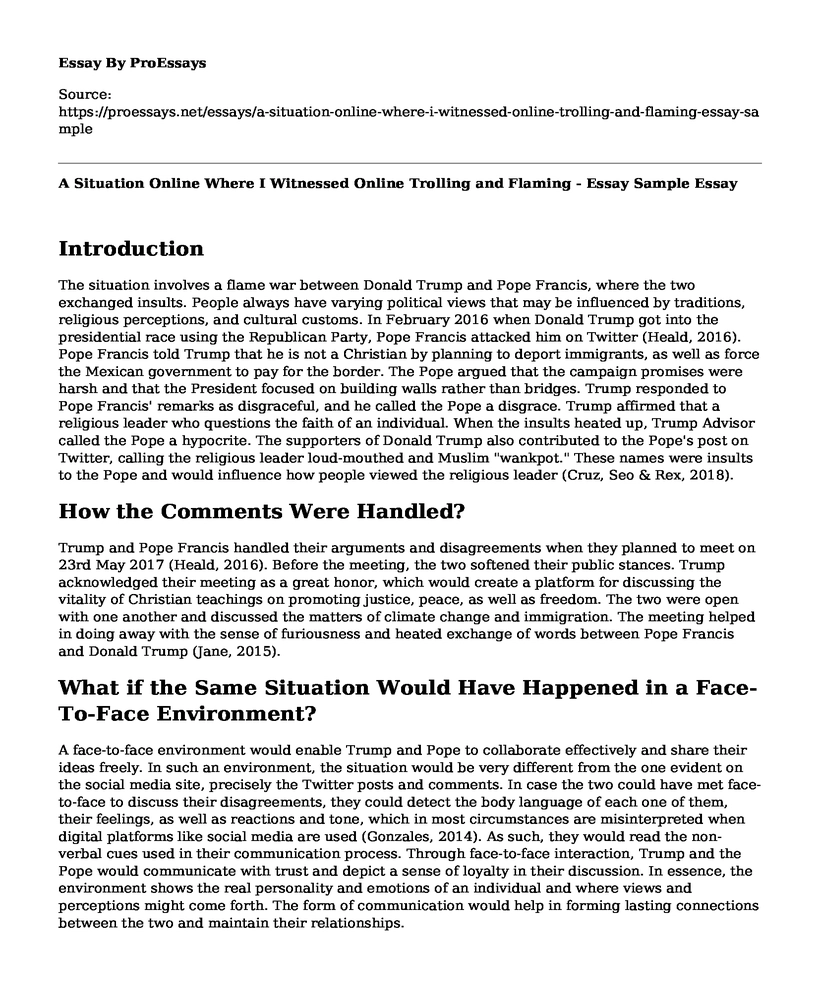Introduction
The situation involves a flame war between Donald Trump and Pope Francis, where the two exchanged insults. People always have varying political views that may be influenced by traditions, religious perceptions, and cultural customs. In February 2016 when Donald Trump got into the presidential race using the Republican Party, Pope Francis attacked him on Twitter (Heald, 2016). Pope Francis told Trump that he is not a Christian by planning to deport immigrants, as well as force the Mexican government to pay for the border. The Pope argued that the campaign promises were harsh and that the President focused on building walls rather than bridges. Trump responded to Pope Francis' remarks as disgraceful, and he called the Pope a disgrace. Trump affirmed that a religious leader who questions the faith of an individual. When the insults heated up, Trump Advisor called the Pope a hypocrite. The supporters of Donald Trump also contributed to the Pope's post on Twitter, calling the religious leader loud-mouthed and Muslim "wankpot." These names were insults to the Pope and would influence how people viewed the religious leader (Cruz, Seo & Rex, 2018).
How the Comments Were Handled?
Trump and Pope Francis handled their arguments and disagreements when they planned to meet on 23rd May 2017 (Heald, 2016). Before the meeting, the two softened their public stances. Trump acknowledged their meeting as a great honor, which would create a platform for discussing the vitality of Christian teachings on promoting justice, peace, as well as freedom. The two were open with one another and discussed the matters of climate change and immigration. The meeting helped in doing away with the sense of furiousness and heated exchange of words between Pope Francis and Donald Trump (Jane, 2015).
What if the Same Situation Would Have Happened in a Face-To-Face Environment?
A face-to-face environment would enable Trump and Pope to collaborate effectively and share their ideas freely. In such an environment, the situation would be very different from the one evident on the social media site, precisely the Twitter posts and comments. In case the two could have met face-to-face to discuss their disagreements, they could detect the body language of each one of them, their feelings, as well as reactions and tone, which in most circumstances are misinterpreted when digital platforms like social media are used (Gonzales, 2014). As such, they would read the non-verbal cues used in their communication process. Through face-to-face interaction, Trump and the Pope would communicate with trust and depict a sense of loyalty in their discussion. In essence, the environment shows the real personality and emotions of an individual and where views and perceptions might come forth. The form of communication would help in forming lasting connections between the two and maintain their relationships.
How Situations Like This Can Be Minimized?
As technologies advance dramatically, the number of people who use social media sites increases substantially thereby making it difficult to do away with the issues of online trolls and flame wars. An effective way to minimize such situations is the use of non-verbal communication in most communications. The one form of non-verbal communication that would be appropriate is face-to-face communication or interaction. Through the interaction, individuals will understand the emotions and reactions of others in the way of gestures, eye contact, and facial expressions (Gonzales, 2014).
Conclusion
People should always consider the need of interacting and sharing their ideas freely not only through the social media platforms but also engage in a face-to-face environment. Non-verbal communication will enable different people to understand voice intonation and body languages of those they share their ideas with as they interact.
References
Cruz, A. G. B., Seo, Y., & Rex, M. (2018). Trolling in online communities: A practice-based theoretical perspective. The Information Society, 34(1), 15-26.
Gonzales, A. L. (2014). Text-based communication influences self-esteem more than face-to-face or cellphone communication. Computers in Human Behavior, 39, 197-203.
Heald, S. (2016). The Pope's Climate Message in the United States: Moral Arguments and Moral Disengagement. Environment: Science and Policy for Sustainable Development, 58(3), 4-13.
Jane, E. A. (2015). Flaming? What flaming? The pitfalls and potentials of researching online hostility. Ethics and Information Technology, 17(1), 65-87.
Cite this page
A Situation Online Where I Witnessed Online Trolling and Flaming - Essay Sample. (2022, Jul 25). Retrieved from https://proessays.net/essays/a-situation-online-where-i-witnessed-online-trolling-and-flaming-essay-sample
If you are the original author of this essay and no longer wish to have it published on the ProEssays website, please click below to request its removal:
- Advantages and Disadvantages of Couchsurfing Paper Example
- Essay Example on Comorbidity of Alcoholism & Gambling: A Dangerous Combination
- The Juvenile Justice and Delinquency Prevention Act: Protecting Youth from Risk in Adult Detentions
- Essay on China's Non-Verbal Communication: Differences in Low-Contact Culture
- Literary Analysis Essay on Lysistrata
- Essay Example on US Security Concerns Rise After Terror Attacks
- The Eroticization of Young Girls: Causes & Consequences - Essay Sample







